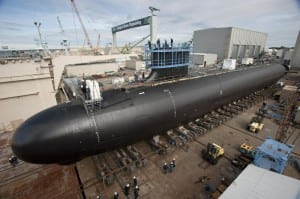Several Navy officials on Wednesday told a House panel why several legislative proposals to enact the tripartite AUKUS agreement are needed this year, or parts of the submarine cooperation plan will be delayed.
“Congress is a critical AUKUS partner. AUKUS can only succeed with the same, continued bi-partisan support demonstrated since the March 2023 announcement of the Optimal Pathway,” Under Secretary of the Navy Erik Raven, Commander of Naval Submarine Forces Vice Adm. William Houston, and Program Executive Officer for Attack Submarines Rear Adm. Jonathan Rucker said in a written opening statement to the House Armed Services Committee’s Seapower and Projection Forces Subcommittee during a hearing on the submarine industrial base (SIB).

In March, the U.S., U.K. and Australia announced the ‘optimal pathway’ for the AUKUS agreement that seeks to help Australia produce its own nuclear-powered submarines (Defense Daily, March 13).
The officials said Congress needs to pass four legislative proposals as part of the fiscal year 2024 defense authorization act in order to stay on schedule.
First, allowing the U.S. to sell Virginia-class attack submarines (SSNs) to Australia “demonstrates the US commitment, sends the right signal to Australia to make proportional contribution into the US SIB, and keeps Pillar One on track. It is critical that this legislation pass without language that could undermine Australian certainty of these U.S. transfers under the agreed upon optimal pathway.”
Under AUKUS, the U.S. plans to sell three to five new and used Virginia-class SSNs to Australia in the early 2030s before Australia starts building and delivering its own SSN-AUKUS boats in the early 2040s.
Australia has committed to contribute $3 billions to the U.S. SIB in addition to paying for the submarines themselves ahead of developing its own industrial base to build and maintain nuclear-powered SSNs.
The Navy officials said passing legislation allowing the sales now will provide enough time to complete “what will be an extremely complicated Foreign Military Sales (FMS) case,” which will allow “Australian personnel to take part in the planning and execution of the major maintenance availability occurring prior to the first planned SSN transfer.”
They said planning for the availability starts within the next two years, so legislation approving this kind of FMS is required this year.
The proposal also includes a provision allowing for maintenance of U.S. submarines in Australia and the U.K. and to be performed by personnel from those countries.
They warned this provision is needed to establish Submarine Rotational Force-West (SRF-W) by late 2027, otherwise that step could be delayed. SRF-W will feature up to four U.S. and one U.K. SSNs based at HMAS Stirling near Perth, Australia before Australia starts receiving its own nuclear-powered SSNs.
“Not passing this legislation will require the U.S. to alter maintenance work associated with planned SSN port visits in 2025, impacting Australia’s ability to build the knowledge, skills and stewardship required to operate SSNs and will likely delay the establishment of SRF-W.”
Another provision allows the U.S. to accept contributions from Australia for the U.S. submarine industrial base, which the Navy revealed is set to start in 2025.
“In addition to paying replacement costs for each [Virginia-class submarine], Australia has committed to make a proportionate financial contribution to the U.S. SIB to accelerate [Virginia-class submarine] delivery. At the United States request, the Australian government has agreed to provide the majority of these funds in 2025. Passing this provision allows the US Government to establish the accounts and structures to properly manage the funds.

The Navy officials said Australia’s contribution is “necessary to augment” Virginia-class submarine] production from 2.0 to a required 2.33 submarines per year to support both U.S. Navy and Australian AUKUS requirements.
The current U.S. SSN production rate is 1.2 to 1.3 submarines per year, while the government currently aims to produce two SSNs per year for domestic needs alone.
“Australia’s investment into the US SIB builds upon on-going efforts to improve industrial base capability and capacity, create jobs, and utilize new technologies. This contribution is necessary to augment VACL production from 2.0 to 2.33 submarines per year to support both US Navy and AUKUS requirements,” Raven, Houston and Rucker said.
They argued sustained investment in the industrial base seeks to ultimately “increase repair capacity and capability of US shipyards to get more SSNs out of maintenance and back to the Fleet.”
The third legislative piece is a training proposal, allowing Australian personnel to be embedded in the U.S. SIB, starting in 2024.
“Without this provision, the number of Australian personnel eligible for training in the US would be well below projected requirements and will negatively impact the establishment of SRF-W,” they said.
The last legislative provision would modify the International Traffic in Arms Regulations laws to better support AUKUS.
The Navy officials said that while this has the largest impact on Pillar Two, which is non-submarine technology cooperation, “it will also allow for enhanced cooperation in Pillar One as well and allow our trilateral industrial partners to better collaborate and innovate.”
They also argued for the submarine industrial base portion of the supplemental funding request President Biden submitted to Congress on October 20 (Defense Daily, Oct. 20).
The Navy officials said this is “critical to improve build and sustainment rates for attack submarines in order to meet U.S. military requirements, and will also support our commitments under AUKUS.”